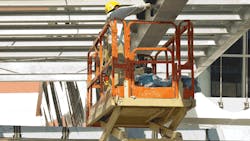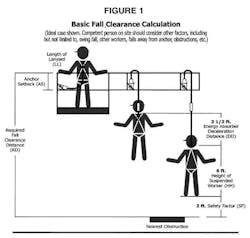The Scissor Lift Dilemma: Guardrails vs. Fall Arrest Systems
It’s important to realize working at heights always has its risks. In fact, falls continue to be the leading cause of death in the construction industry, and as of 2011, falls rank No.1 on OSHA’s top 10 most serious violations. OSHA requires the use of fall protection equipment anytime a fall of 6 feet or more is possible on a construction site.
Many construction contractors utilize scissor lifts for employees working at height. The first scissor lifts were built in the 1970s. Although improvements in materials and safety have been made since then, the basic underlying design has stayed the same. Scissor lifts use an “x” pattern, known as a pantograph folding support, to move the platform up and down vertically. Several models also come equipped with an extending bridge, giving the user closer access to the work area.
The scissor lift remains a popular work tool, due in part to its ease of mobility and compact storage space. Once properly trained on its use, a worker can drive it directly to the work area and extend it to the desired height. When finished, it easily retracts and stores for future use. Today, scissor lifts can be found everywhere: retail establishments, manufacturing operations, construction sites and any place that may require access to heights.
According to the American National Safety Institute (ANSI), guardrails are considered an acceptable form of fall protection; however, guardrails do not completely eliminate the possibility of a fall from a scissor lift. Most scissor lifts meet the height requirement for guardrails as the only form of protection required (42 inches, +/- 3 inches), but there still exists the possibility a worker could fall through the space below the mid rails or over the top rail. A competent person, as defined by OSHA, should evaluate the fall hazard and take corrective measures to eliminate it.
One such corrective measure is the use of an approved fall arrest system. A complete personal fall arrest system will include the anchor point, connector, body support and in the event of a fall, prompt rescue. Fall arrest systems are designed to arrest a worker’s fall and reduce the arrest forces on the worker’s body to an acceptable level.
Anchor Points
When installing a fall arrest system on a scissor lift, the anchor point location perhaps is the most important consideration. Understand that a guardrail may not meet the required anchor strength, and if it does not, it renders your fall protection system useless. Most scissor lifts include an approved fall protection anchor point that clearly is marked to ensure a properly rated anchor point is used
Once a designated anchor point is established, decide which lifelines and lanyards work best for each particular site. Fall arrest system manufacturers have developed lightweight, versatile self-retracting lifelines (SRLs) that attach to an approved anchor point in the lift to help reduce the fall distances required by traditional shock absorbing lanyards. Industry-leading SRLs, weighing as little as 1.6 pounds, can be attached directly to the worker’s harness, making them convenient and comfortable for the user. The design of the SRL allows worker mobility through the use of a retracting lifeline that recoils freely during normal working conditions and in the event of a fall will engage a locking mechanism. Most SRLs have an average fall clearance of approximately 4.5 feet – less than half of the distance requirement for shock-absorbing lanyards.
Fall arrest systems require a basic fall clearance calculation before use. The average fall clearance required when utilizing a shock-absorbing lanyard can be in excess of 16.5 feet. Many operations performed on scissor lifts are done at an average height of 14 feet, so there is a high risk of striking a lower level or obstruction in the event of a fall if the necessary precautions are not taken. A full awareness of the distance to the lower level must be considered.
The Aerial Lift Association outlines its recommended best practices for fall distance when working on elevated platforms (see Fig. 1). Whether a shock absorbing lanyard is used or a SRL, make sure when calculating clearance requirements that you factor in where the anchor point is located and (if applicable) the distance from the anchor point up to the railing, then downward.
The role of the safety professional has taken on a very complex dynamic. EHS professionals must maintain worker safety while balancing time deadlines and budget restraints. Scissor lift use has seen an increase in demand for this reason. They provide access to jobs at lower heights with a stable work surface to stand on.
However, simply providing the equipment is only half of the requirement. The development of an adequate and competent training program is an essential tool in establishing a safe work environment. The standards for training outline that all workers required to work at heights demonstrate proficiency in the recognition of hazards and must be provided with fall protection. For training to be effective, it should combine classroom education with a “hands on” demonstration.
According to the U.S. Bureau of Labor Statistics, in 2011, falls to lower level accounted for 541 fatal work injuries. Of those cases were the height of fall was known, 57 percent involved falls of 20 feet or less (see Fig. 2). Further research indicates that of the 541 fatalities related to falls, 250 were in the construction industry. This number represents a variety of construction trade workers, including brick masons, carpenters, construction laborers, drywall installers, electricians, painters, pipe layers, plasterers, roofers, sheet metal workers, bridge and building inspectors, mechanics, linemen and the supervisors.
Construction companies are the main operators of scissor lifts. These numbers give us greater cause to ensure that protection at heights is given the top priority. Ensure that when workers are performing any duties at heights, they are managing a primary and secondary approach to fall protection. The primary and secondary approach to fall protection states that all workers should have two systems or lines of defense against falling. Just placing employees in a scissor lift with guardrails is not enough.
Staying safe on scissor lifts doesn’t have to be difficult. Ensuring your workers’ safety is of the utmost importance and supplying the right fall protection equipment is one easy solution.
Like this article? Subscribe to EHS Today Magazine to receive leading coverage of the EHS industry.
Rick Argudin is a training specialist with Capital Safety and can be reached at [email protected]. Capital Safety is a leading designer and manufacturer of height safety and fall protection equipment. Capital Safety also offers training courses, with 20 operating sites worldwide.


